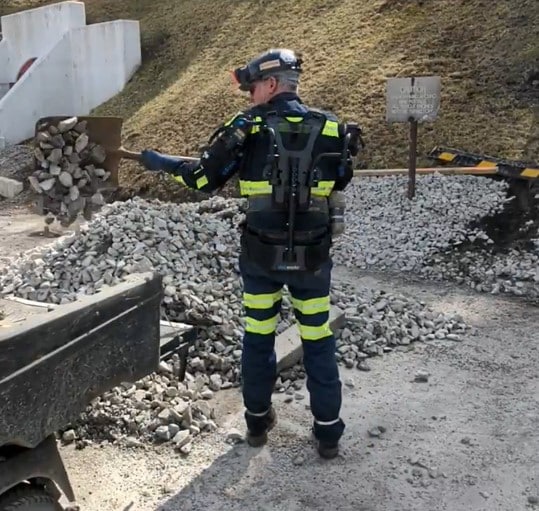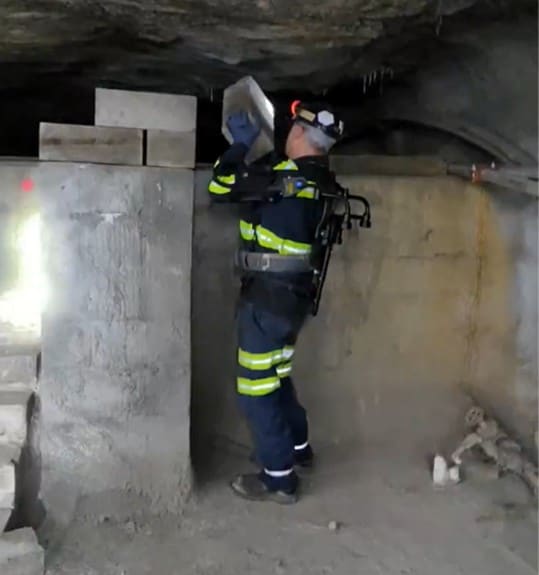Mining Project: Using Exoskeletons to Reduce Overexertion Injuries
| Principal Investigator |
|
|---|---|
| Start Date | 10/1/2023 |
| Objective |
Mining exposes miners to repetitive and sustained physical exertion that may lead to overexertion injuries. Overexertion was the second leading cause of injuries from 2017-2021 and accounted for 24.5% of injuries with lost time from work or restricted activity. Work that requires effort beyond an individual’s physical abilities or by repeated cumulative microtrauma can cause overexertion injuries. Overexertion can result in muscle strains, sprains, and tears. Exoskeletons are increasingly used to reduce this physical loading of repetitive or sustained tasks, with studies evaluating their short- and long-term effectiveness. While exoskeletons are more commonly used in automotive manufacturing and the military, limited research has evaluated the efficacy of exoskeleton use for mining tasks. Current research is limited to use on the shoulders during a manual materials handling task. To expand this important area, this project focuses on passive exoskeletons, worn on the shoulder, back, or other body parts, and their potential for overexertion injury prevention. In addition, the project includes field evaluations and collects information on users’ perceptions. This effort evaluates exoskeletons in real-life scenarios to determine their efficacy to reduce physical demands in the mining environment and their potential to reduce the risk of overexertion injuries. |
| Topic Areas |
Research Summary
Approach
To evaluate exoskeleton efficacy for overexertion injury prevention, researchers will collect information through both field and laboratory evaluation. First, field observations, conversations with interested parties, and injury and illness data analysis will identify tasks that lead to overexertion injuries and tasks that are viable for exoskeleton use. Second, identified tasks will be performed in the laboratory to objectively evaluate the physical demands without an exoskeleton and while wearing an exoskeleton. Finally, a field evaluation will assess user acceptance, performance, usability, and fit of the exoskeleton while performing the tasks in real-life scenarios over a one-month period.
Researchers will collaborate with the mining community to ensure the success of this project and to determine the effectiveness of exoskeletons at reducing the physical demands of the selected mining tasks. This work relies on collaborating with mine sites and mine workers who are willing to evaluate the exoskeletons. Mining partners will be recruited in the initial stage of the research and will continuously work together throughout the duration of the project. Partners will help to identify tasks leading to overexertion injuries that may benefit from exoskeleton use. Mine workers will also evaluate the usability and functionality of the exoskeleton. Ultimately, NIOSH researchers will provide final recommendations for exoskeleton use in the mining industry to reduce overexertion injuries based on feedback from interested partners and laboratory results.
Milestones and Accomplishments
| Description | Audience | Year |
|---|---|---|
| Compile list of tasks and exoskeletons for evaluation based on field observation and injury data analysis | Internal to NIOSH—to conduct exoskeleton testing | 2024 |
| Obtain Institutional Review Board (IRB) and Office of Management and Budget (OMB) approval for laboratory and field testing | Internal to NIOSH—to conduct exoskeleton testing | 2024-2025 |
| Provide recommendations for exoskeleton use to reduce mining overexertion injuries | Academia and health and safety professionals at mining operations | 2025 |
Planned Impacts and Outcomes
From both laboratory and field data, researchers will identify strengths and weaknesses of exoskeleton use for different mining tasks. Researchers will provide recommendations for selecting and using exoskeletons while performing these tasks. Findings can be used by mines for internal decision making related to musculoskeletal disorder prevention. Based on this work, viable exoskeletons may be used by the mining industry, if found to be beneficial, and any burden from unsuitable design or use will be avoided. This research could reduce overexertion injuries and further lead to a reduction in musculoskeletal disorders in mining. This will be accomplished through publications and interaction with the mining industry.
This project does not explicitly evaluate impact, and dissemination is limited to publishing and presenting the work. Measuring the effectiveness of this work can be done at three levels: (1) evaluation of the awareness of the research conducted by NIOSH on preventing overexertion injuries, (2) evaluation of the use of solutions or recommendations, and (3) measurement of eventual changes to health and safety outcomes, such as injuries.
Outputs
Based on the results from this project, a journal paper will be written to provide final recommendations for exoskeleton use for reducing mining overexertion injuries. Presentations, journal articles, publications in mining trade magazines, and stickers will be created for researchers, mine managers, mine health and safety personnel, and mine workers. Additionally, an internal report will be published identifying the mining tasks and applicable exoskeletons. The peer-reviewed journal paper will include the results from evaluations of exoskeletons during a mining task and performance and perceptions of using exoskeletons.
Supporting Visuals

A mine worker wearing a passive, shoulder support exoskeleton while shoveling materials.

An exoskeleton being used while a mine worker builds a stopping at an underground research mine.
- A Comparison of Longwall & Continuous Mining Safety in U.S. Coal Mines 1988-1997
- A Deeper Look at Contractor Injuries in Underground Coal Mines
- A General Framework for Prioritizing Research To Reduce Injuries and Diseases in Mining
- Independent Contractor Trends in the United States Mining Industry
- Machine Injury Prediction by Simulation Using Human Models
- Operationalizing Normal Accident Theory for Safety-Related Computer Systems
- Physical Strength Assessment in Ergonomics
- Potential of Roof Screening to Reduce Workers' Compensation Cost
- Verification and Validation of Roof Bolter Simulation Models for Studying Events Between a Machine and its Operator
- Visual Performance for Trip Hazard Detection When Using Incandescent and LED Miner Cap Lamps